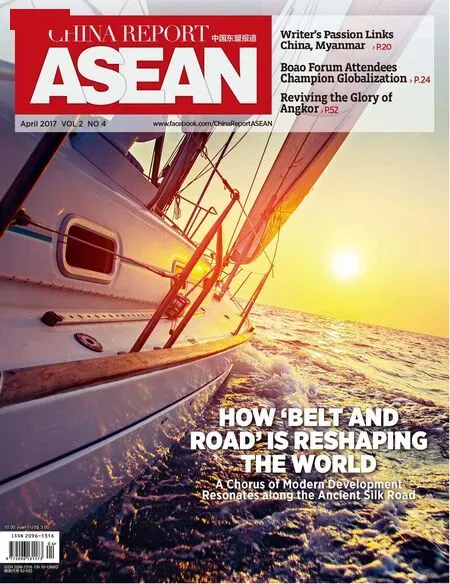Ancient Trade Route to be Revitalized
By Oh Ei Sun
Ancient Trade Route to be Revitalized
By Oh Ei Sun
The Contemporary Significance of the Maritime Silk Road from a Southeast Asian Perspective
ABOUT THE AUTHOR
Oh Ei Sun is a senior research fellow at Nanyang Technological University in Singapore. He served as political secretary to the prime minister of Malaysia from 2009 to 2011.
Due to Southeast Asia’s geographical position as a link between East and West, commercial activities and international trade have contributed greatly to local people’s livelihoods. In this sense, to help the Belt and Road Initiative win public support in Southeast Asia, efforts should be focused on expanding business opportunities while providing improved safety guarantees.
As a scholar based in Southeast Asia, I would like to illustrate Southeast Asian expectations for the 21st Century Maritime Silk Road.
‘Belt and Road’ Economic Hub
For centuries in some Southeast Asian countries, economic growth has relied heavily on trade. My home country, Malaysia, for example, is now China’s leading trade partner in Southeast Asia. To these countries, the greatest significance of the Belt and Road is simple — deepening and expanding trade with China and other nations along the route. From their perspective, key points are exploring new fields of trade in goods and services and promoting economic integration by opening more of their economic areas for the participation of other economies, especially in interactions with China.
In the meantime, some other countries in the region, despite abundant natural resources, have failed to fulfill their economic potential due to outdated infrastructure. To them, China’s assistance in the construction of infrastructure, including highways, railroads, ports, air transport and telecommunication, on the premise of mutual benefit, would be of great significance.
It is known to many that the Silk Road Economic Belt covers regions outside of South Asia, the Middle East and East Africa. Some countries in Southeast Asia, such as Malaysia, not only embrace cultural diversity, but have been highly exposed to Islamic and South Asian cultures. Therefore, as a“super transfer station” along the Belt and Road, Southeast Asia can play an active role in coordinating communication and exchange between China and regions far from the reach of the Silk Road Economic Belt, which will yield surprising and positive results.
Of course, Southeast Asian countries also hope to expand their ties with other emerging or developed economies through the implementation of the Belt and Road Initiative. It would be ideal if the Initiative could help them establish links with nations along Arctic shipping routes or increase exchanges with the Eurasian Economic Union, which includes Russia and some other Eastern European and Central Asian countries.
Closer people-to-people bonds between nations along the routes, particularly interactions between small and medium-sized enterprises, are equally important to the success of realizing the Belt and Road vision. With progress made in this respect, a community of shared future in a true sense can be expected.
Adjusting to Local Conditions
While promoting the construction of the new Maritime Silk Road, we should keep local conditions in mind. Many Southeast Asian economies remain backward compared to Western developed countries and even modern China. Therefore, when it comes to infrastructure construction, they attempt to skip the stage of relatively outdated technological development but “l(fā)eap straight into” one characterized by the newest and most advanced science and technology.
However, such a “shortcut”development strategy is not always workable for all fields of infrastructure. For instance, though it is true that many Southeast Asian regions need better rail networks to moreeffectively transport various goods so as to release greater economic vitality, on many occasions what they really want is basic, medium or low-speed rail transportation instead of state-of-the-art highspeed trains. High-speed rail services between Singapore and Kuala Lumpur may help facilitate communications among businesspeople and other professionals in these two commercial hubs of Southeast Asia, and are expected to bring in even higher value added, but opinions differ on whether or not high-speed railway construction can yield tangible economic benefits in countries like Laos, Cambodia and Thailand.

On Oct. 16, 2015, a Chinese consortium led by China Railway Company and an Indonesian consortium led by PT Pilar Sinergi BUMN Indonesia signed an agreement to launch a joint venture for the development of a high-speed railway linking Jakarta and Bandung.
Like China, many Southeast Asian countries are home to multiple ethnic groups, boasting colorful cultural diversity.
Overseas Chinese’ Role as a Bridge
Like China, many Southeast Asian countries are home to multiple ethnic groups, boasting colorful cultural diversity. Overseas Chinese youth, wherever they are, should consider how to modernize and popularize their traditional cultural essences; or, to put it more simply, how to spark the interest of younger generations in these cultures.
In this regard, China’s entertainment businesses have done a great job over the past few years. Later on, with coordination from overseas Chinese and based on field investigations, they can set up some bases in Southeast Asian cities to bolster local cultural creativity, or establish film and TV studios to promote mutual cultural understanding between China and target countries.
In terms of education and scientific research, overseas Chinese youth can work to create opportunities in cross-border advanced study and internships in colleges and firms for young people, so as to promote talent cultivation and boost friendship among regional peoples.
Southeast Asia is home to the oldest tropical rainforest in the world, where many species of flora and fauna have yet to be named by scientists, not to mention their respective practical value and medical effects. Thus, cooperation between traditional Chinese medicine experts and local biological research institutes in the study of those species will eventually bring benefit to mankind.
It is no doubt that the Belt and Road Initiative has been warmly received by governments and citizens alike in Southeast Asia. If the implementation of this forward-looking initiative can be better integrated with the actual conditions of nations involved, even more promising prospects lie ahead.

